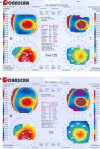Keratoconus: current perspectives
- PMID: 24143069
- PMCID: PMC3798205
- DOI: 10.2147/OPTH.S50119
Keratoconus: current perspectives
Abstract
Keratoconus is characterized by progressive corneal protrusion and thinning, leading to irregular astigmatism and impairment in visual function. The etiology and pathogenesis of the condition are not fully understood. However, significant strides have been made in early clinical detection of the disease, as well as towards providing optimal optical and surgical correction for improving the quality of vision in affected patients. The past two decades, in particular, have seen exciting new developments promising to alter the natural history of keratoconus in a favorable way for the first time. This comprehensive review focuses on analyzing the role of advanced imaging techniques in the diagnosis and treatment of keratoconus and evaluating the evidence supporting or refuting the efficacy of therapeutic advances for keratoconus, such as newer contact lens designs, collagen crosslinking, deep anterior lamellar keratoplasty, intracorneal ring segments, photorefractive keratectomy, and phakic intraocular lenses.
Keywords: collagen cross-linking; contact lenses; corneal topography; hydrops; keratoconus; keratoplasty.
Figures






References
-
- Grzybowski A, McGhee CN. The early history of keratoconus prior to Nottingham’s landmark 1854 treatise on conical cornea: a review. Clin Exp Optom. 2013;96(2):140–145. - PubMed
-
- Nottingham J. Practical Observations on Conical Cornea. London, UK: Churchill; 1854.
-
- McGhee CN. 2008 Sir Norman McAlister Gregg Lecture: 150 years of practical observations on the conical cornea – what have we learned? Clin Experiment Ophthalmol. 2009;37(2):160–176. - PubMed
-
- Li X. Longitudinal study of the normal eyes in unilateral keratoconus patients. Ophthalmology. 2004;111(3):440–446. - PubMed
-
- Klyce SD. Chasing the suspect: keratoconus. Br J Ophthalmol. 2009;93(7):845–847. - PubMed
Publication types
LinkOut - more resources
Full Text Sources
Other Literature Sources
Medical
Miscellaneous

